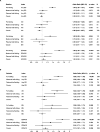This is a preprint.
The role of co-occurring conditions and genetics in the associations of eating disorders with attention-deficit/hyperactivity disorder and autism spectrum disorder
- PMID: 39070652
- PMCID: PMC11275993
- DOI: 10.21203/rs.3.rs-4236554/v1
The role of co-occurring conditions and genetics in the associations of eating disorders with attention-deficit/hyperactivity disorder and autism spectrum disorder
Update in
-
The role of co-occurring conditions and genetics in the associations of eating disorders with attention-deficit/hyperactivity disorder and autism spectrum disorder.Mol Psychiatry. 2025 May;30(5):2127-2136. doi: 10.1038/s41380-024-02825-w. Epub 2024 Nov 14. Mol Psychiatry. 2025. PMID: 39543370 Free PMC article.
Abstract
Eating disorders (EDs) commonly co-occur with other psychiatric and neurodevelopmental disorders including attention-deficit/hyperactivity disorder (ADHD) and autism spectrum disorder (ASD); however, the pattern of family history and genetic overlap among them requires clarification. This study investigated the diagnostic, familial, and genetic associations of EDs with ADHD and ASD. The nationwide population-based cohort study included all individuals born in Denmark, 1981-2008, linked to their siblings and cousins. Cox regression was used to estimate associations between EDs and ADHD or ASD, and mediation analysis was used to assess the effects of intermediate mood or anxiety disorders. Polygenic scores (PGSs) were used to investigate the genetic association between anorexia nervosa (AN) and ADHD or ASD. Significantly increased risk for any ED was observed following an ADHD [hazard ratio = 1.97, 95% confidence interval = 1.75-2.22] or ASD diagnosis [2.82, 2.48-3.19]. Mediation analysis suggested that intermediate mood or anxiety disorders could account for 44-100% of the association between ADHD or ASD and ED. Individuals with a full sibling or maternal halfsibling with ASD had increased risk of AN [1.54, 1.33-1.78; 1.45, 1.08-1.94] compared to those with siblings without ASD. A positive association was found between ASD-PGS and AN risk [1.06, 1.02-1.09]. In this study, positive phenotypic associations between EDs and ADHD or ASD, mediation by mood or anxiety disorder, and a genetic association between ASD-PGS and AN were observed. These findings could guide future research in the development of new treatments that can mitigate the development of EDs among individuals with ADHD or ASD.
Conflict of interest statement
Conflict of interest Dr. Bulik is an author and royalty recipient from Pearson. D.D. had received speaker fee from Medici Nordic. The remaining authors declare no conflict of interest.
Figures





References
Publication types
Grants and funding
LinkOut - more resources
Full Text Sources

